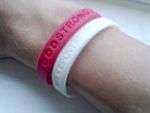Wristband
Wristbands are encircling strips worn on the wrist or lower forearm. The term can be used to refer to a bracelet-like band, similar to that of a wristwatch, to the cuff or other part of a sleeve that covers the wrist, or decorative or functional bands worn on the wrist for many different reasons. Wristbands are often worn and used similarly to event passes such as lanyards to information or allow people entry to events. These wristbands are made from loops of plastic that are placed around the wrist and are used for identification purposes (demonstrating the wearer's authorization to be at a venue, for example).


Another type of wristband is the sweatband; usually made of a towel-like terrycloth material. These are usually used to wipe sweat from the forehead during sport but have been known to be used as a badge or fashion statement. A practice common in mid-1980s punk subculture was to cut the top off of a sock and fashion the elastic into this type of wristband.
Silicone wristbands

In the early-to-mid-2000s (decade), bracelets often made of silicone became popular. They are worn to demonstrate the wearer's support of a cause or charitable organization, similar to awareness ribbons. Such wristbands are sometimes called awareness bracelets to distinguish them from other types of wristbands. In early 2007 they became an increasingly popular item being sold as merchandise at concerts & sporting events worldwide. The wristbands bearing official logos or trademarks enabled the seller to offer a low price point merchandise option to fans. Silicone wristbands may also be called gel wristbands, jelly wristbands, rubber wristbands and fundraising wristbands.[1] All of these wristbands are made from the same silicone material.
UV ultra violet wristbands
UV Ultra Violet Sensitive silicone wristbands appear clear/white when out of UV light, but when exposed to ultra violet light such as sunlight the wristbands' color changes to blue or fuchsia. These bands can be used as reminders for people to apply sunscreen or stay in the shade on hot summer days.
Hospital wristbands

Hospital wristbands are a commonly used safety device for identifying patients undergoing medical care (see patient safety and medical identification tag). Available in a variety of sizes to accommodate patients as small as newborns and as large as obese adults, hospital wristbands can be handwritten, embossed, laser-printed or thermal-imaged with names, pictures, medical record numbers, barcodes and other personal identifiers.
Laser printing and thermal imaging—the most advanced technologies for personalizing hospital wristbands—support fonts, colors and barcodes for improved patient safety through electronic patient and medication tracking. Handwritten and embossed wristbands remain in widespread use, however, despite findings on compromised safety reported in 2007. The National Patient Safety Agency (NPSA) found that as many as 2,900 patients each year were receiving the wrong medical care because of the hospital staff's inability to read damaged or otherwise illegible patient information on handwritten and embossed wristbands.[2]
Event wristbands

Colored wristbands are often given to people attending events such as music festivals and gigs, as an access control measure. Counterfeit wristbands are increasingly common.[3][4]
Silicone Wristbands (some times referred to as Gel bracelets) are popular for fundraising or showing support for a cause. Custom wristbands are usually created by an event organizer and given out or sold to others interested in the event or supporting the cause.
Some people keep the wristbands as souvenirs or wear the wristbands after the event to show what events they went to.[5]
Further uses for the wristband in event ticketing at music festivals and sporting events may include an NFC (near field communication) chip that would allow contactless payment at the concessions and turnstiles. Wristbands are ideal to use for dark environments such as night clubs and bars or outdoor venues where patrons can be afar such as festivals and theme parks.
In addition these styles of colored wristbands are used with the above listed hospital patient bands to serve as an extra safety reminder and alert for Allergies. They will have a standard color and will have written labeling such as "Fall Risks" (which may come from medical conditions, injuries and/or medications used with the possibility of all of the above causing the increased safety risk warning), "Allergies" (to cover allergic reactions to vast to list per band type risks), "Latex Allergies" (to make sure medical safety gloves are not made of latex which is an immediate risk more than other allergies), amongst several other important cautions that would protect the patient by preventing Iatrogenic mistakes, reducing additional medical complications.
See also
References
- Molesworth, Harley (1 January 2019). "A Comprehensive Guide To Silicone Wristbands". Wristbands.co.uk. Harley Molesworth. Retrieved 1 January 2019.
- http://www.nrls.npsa.nhs.uk/resources/?entryid45=59824
- Boyd, Brian (27 November 2009). "Coming soon to a music festival near you: the wristband racket". Irish Times. Retrieved 13 June 2010.
- "Reading And Leeds Festival organiser warns fans against ticket and wristband scam". NME. 5 March 2010. Retrieved 13 June 2010.
- O'Reilly, John (2002). No brief: graphic designers' personal projects. Rockport Publishers. ISBN 2-88046-694-6.